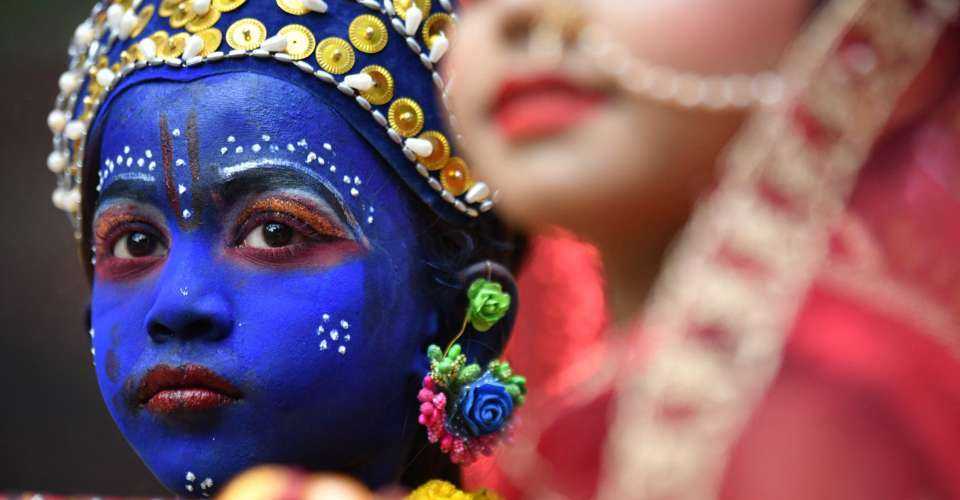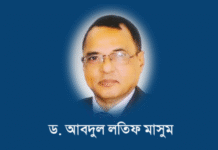
A young child dressed as the Hindu god Lord Krishna takes part in a celebration for the Janmashtami festival in Dhaka on Aug. 19, 2022. Minority Hindus came under a series of attacks during the deadly Bangladesh unrest that topped the Awami League government on Aug. 5. (Photo: Syed Muhamudur Rahman /NurPhoto via AFP)
Purnima Sanyal* asked her Muslim husband in the early hours of Aug. 5 to change her Hindu name to Muslim to conceal her real identity.
A liberal Muslim, Irfanul Islam* found his wife’s unprecedented request pragmatic as they witnessed violent attacks on minority Hindus amid the deadly political unrest in Bangladesh.
“Days of violence shook my wife to her core. She no longer felt safe being a minority,” Islam, who works with a private firm in Dhaka, told UCA News.
Bangladesh descended into chaos hours before long-reigning Prime Minister Sheikh Hasina of the ruling Awami League (AL) party resigned and fled the country on Aug. 5, following the student-led nationwide protests.
Hasina’s ouster marked the end of her 15-year authoritarian rule, which survived three allegedly rigged and controversial national elections in 2014, 2018, and 2024.
Since protests turned violent on July 16, at least 439 people, including children and young students, have died in a series of violence, including the firing of police and armed cadres of AL and its collaborators, local media reported.
At least 114 people, including 14 policemen, were killed on Aug. 5, and another 108 died in clashes the next day, according to leading Bengali daily Prothom Alo (First Light).
Among those killed were AL leaders and supporters. Since Aug. 5, Hindu villages, temples, and businesses have been targeted as Hindus are seen as AL supporters in this Muslim-majority nation.
Attacks on Hindus
More than 250 Hindu houses, temples, and businesses were torched, looted, and vandalized in the past two days in 20 districts across the country, according to the minority rights forum, Bangladesh Hindu Buddhist Christian Unity Council (BHBCUC).
At least five temples were attacked, one cremation ground was occupied, and women were physically assaulted in attacks targeting Hindu villages.
“The situation is bleak. Minorities are overwhelmed with attacks,” said Rana Dasgupta, the council’s general secretary.
During an attack, at least 70 Hindu families fled a Hindu-majority village in the southwestern Bagherhat district. They spent their night under the open sky in a beel, a wetland used for agriculture during the dry season.
As millions cheered and celebrated the fall of the Hasina government on the streets of Dhaka and in other major cities, a group of people went on a plundering spree.
Social media audio-visuals showed thousands of people looting and ransacking the residences of former ministers and AL leaders, including Gonobhaban, the official residence of Hasina in Dhaka on Aug. 5. Many also intruded into the National Assembly building and looted whatever they could.
With no government in place and no police on the streets due to a series of attacks on police stations, many families passed sleepless nights on Aug. 4-5.
The military chief Waker-Uz-Zaman called on the people to calm down and refrain from anarchy during his address on Aug. 5, shortly after Hasina fled the country.
He said an interim government would soon be formed based on the consensus of political parties, civil society, and student leaders.
He added that there was no need to impose an emergency or curfew if people remained patient and followed his instructions.
“This is the ideal time for the predators to prey,” Dasgupta said, calling on the army to protect minorities and form the interim government quickly to restore law and order.
He said many leaders of Bangladesh Puja Udjapan Parishad, the top Hindu religious body that oversees the nationwide Puja festival of Hindus, also came under attack in the past two days.
The Radhagobinda temple in Kuakata of the southern coastal district of Patuakhali was looted and vandalized.
In Keshabpur of Jashore, a southwestern district, at least 40 Hindu houses were looted and vandalized.
About 50 shops were torched in Chourongibazar of the northern district of Dinajpur, where some Muslims occupied a cremation ground for hours before being driven away.
In Lohagora of Narail, women were assaulted during an attack on 25 Hindu houses, alleged the BHBCUC.
Peaceful movement turns violent
The Students Against Discrimination, a movement of university students, began non-violent demonstrations on July 1, demanding reforms in the public service jobs quota system.
It soon became a nationwide anti-government movement after Hasina and her cabinet ministers made derogatory remarks against the protesters and refused to hold talks with their representatives. Police and ruling party supporters jointly unleashed a brutal crackdown, fanning the fire of students’ anger.
The government imposed nationwide curfew, deployed military and slapped internet blackouts for days to defuse the protests but failed.
Amid the political instability, other minority groups also have faced attacks.
Philemon Baske, a Catholic and Santal leader of the northern Gaibandha district, said the Christian-majority community came under several attacks since July 18.
In one case, a group destroyed a tractor worth about 2.7 million taka (US$23,014).
Santal tribal people tried to file a criminal case but failed due to the internet blackout, Baske said.
On July 25, rice crops in some 1.5 hectares were destroyed by another group.
Since mid-July, local Muslims occupied over 13.35 hectares of land in Bagda farm area of Gainbandha, he said.
Santal people sought police help, but the police were busy handling the protesters, he added.
“We have lived confined ever since the unrest began. We are so scared,” said Bichitra Tirkey, president of Jatiya Adivasi Parishad, a tribal rights forum covering northern Bangladesh.
Victimization of minorities
Dasgupta said religious and ethnic minorities are often victimized during political movements in Bangladesh.
He referred to the case of Haradhon Hira, a Hindu AL leader from northern Rangpur district who was killed in a mob violence on Aug. 4.
Hira’s dead body was carried around Rangpur City and hung from a bridge for two hours before he was taken to the funeral site. During that time, over 50 Hindu houses and temples were attacked and vandalized.
In some places, the mobs chanted anti-Hindu slogans, asking them to migrate to neighboring Hindu-majority India.
Observers say the targeting of Hindus stems from two reasons – the Indian government’s open support for Hasina and AL, and the Bangladeshi Hindus’ support for AL.
The targeting of Hindus brought back memories of the 1991 anti-Hindu riots, allegedly orchestrated by Hussain Muhammad Ershad, who was Bangladesh’s president from 1983 to 1990, heading a military dictatorship.
Hindus were also targeted after the national election of 2001, which saw the four-party alliance led by the Bangladesh Nationalist Party (BNP), the second-largest party, and Jamaat-e-Islami, the largest Islamist party, come to power.
The Awami League regime banned Jamaat on Aug. 1.
Before 1971, when Bangladesh was part of Pakistan, Hindus were victimized and attacked with state patronage, Dasgupta said.
About 90 percent of Bangladesh’s estimated 170 people are Muslims, about 8 percent are Hindus, and the rest belong to other faiths, including Christianity and Buddhism.
Attacks on Hindus are common during national elections.










